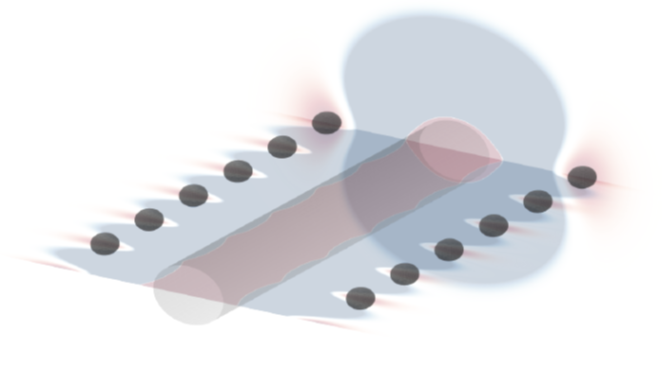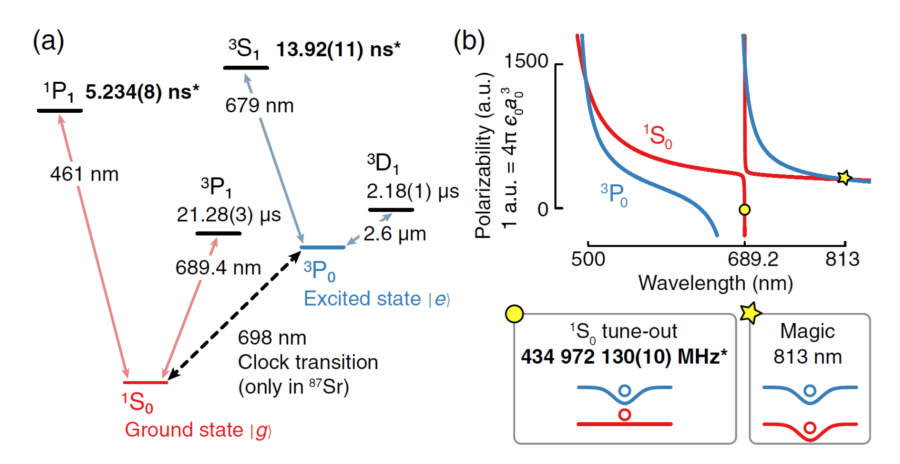Ultracold atoms and quantum simulation
Recent research highlights
State-Insensitive Trapping of Alkaline-Earth Atoms in a
Nanofiber-Based Optical Dipole Trap
Hybrid quantum systems with cold atoms coupled to photonic devices are a strong candidate for building atomtronic circuits; quantum circuits analogous to electronic circuits based on atomic matter waves instead of electrons. Cold atoms trapped in free-space optical potentials have already realized integrated atomtronic elements, and similarly, ring-shaped Bose-Einstein condensates have been tailored for quantum sensing. However, photonic integrated circuits that can realize near-surface optical and magnetic trapping potentials offer more compact and diverse geometries to coherently control and manipulate matter waves. Neutral atoms trapped in the evanescent optical potentials of nanotapered optical fibers are a promising platform for developing quantum technologies and exploring fundamental science, such as quantum networks and quantum electrodynamics. In this work, the experimental team at UC San Diego demonstrated a state-insensitive optical dipole trap for strontium-88, with the evanescent fields of a nanotapered optical fiber using our predicted value of the magic wavelength.

Strontium atoms (dark grey spheres) are confined radially, azimuthally, and axially along the nanofiber
State-Insensitive Trapping of Alkaline-Earth Atoms in a Nanofiber-Based Optical Dipole Trap,
K. Ton, G. Kestler, D. Filin, C. Cheung, P. Schneeweiss, T. Hoinkes, J. Volz, M. S. Safronova,
A. Rauschenbeutel, J. T. Barreiro, PRX Quantum 4, 040308 (2023).
State-dependent optical lattices for the strontium optical qubit

(a) Simplified Sr level diagram. Optical dipole traps in the red and infrared for the ground (g) and excited (e) qubit (clock) states of Sr are given by coupling to two low-lying singlet and triplet states, respectively. (b) The trap depth for each clock state as a function of wavelength is proportional to the dynamic dipole polarizability. At the “magic wavelength” (star), g and e experience the same trap depth. At the “tune-out wavelength” (circle), an atom in g is free to move, while an atom in e remains trapped.
This work demonstrated state-dependent optical lattices for the Sr optical qubit at the tune-out wavelength for its ground state, predicted by our theoretical computations. The excited state atoms were tightly trapped while suppressing the effect of the lattice on ground state atoms by more than four orders of magnitude. This highly independent control over the qubit states removes inelastic excited state collisions as the main obstacle for quantum simulation and computation schemes based on the Sr optical qubit. Our results also reveal large discrepancies in the atomic data used to calibrate the largest systematic effect of Sr optical lattice clocks.
State-dependent optical lattices for the strontium optical qubit, A. Heinz, A. J. Park, N. Santic, J. Trautmann, S. G. Porsev, M. S. Safronova, I. Bloch, and S. Blatt, Phys. Rev. Lett. 124, 203201 (2020).
Other relevant recent publications
- Coherent excitation of a μHz scale optical magnetic quadrupole transition, V. Klüsener, S. Pucher, D. Yankelev, J. Trautmann, F. Spriestersbach, D. Filin, S. G. Porsev, M. S. Safronova, I. Bloch, S. Blatt, arXiv:2401.03934, accepted to Phys. Rev. Lett. (2024)
- Motional ground-state cooling of single atoms in state-dependent optical tweezers, Christian Hölzl, Aaron Götzelmann, Moritz Wirth, Marianna S. Safronova, Sebastian Weber, Florian Meinert, Phys. Rev. Research 5, 033093 (2023).
- Optical Telecommunications-Band Clock based on Neutral Titanium Atoms, Scott Eustice, Dmytro Filin, Jackson Schrott, Sergey Porsev, Charles Cheung, Diego Novoa, Dan M. Stamper-Kurn, Marianna S. Safronova, Phys. Rev. A 107, L051102 (2023).
- Magic wavelengths of the Sr (5s2 1S0 – 5s5p 3P1) intercombination transition near the 5s5p 3P1 – 5p2 3P2 transition, Grady Kestler, Khang Ton, Dmytro Filin, Marianna S. Safronova, and Julio T. Barreiro, Phys. Rev. A 105, 012821 (2022).
- Measurement of the tune-out wavelength for 133Cs at 880 nm, Apichayaporn Ratkata, Philip D. Gregory, Andrew D. Innes, Jonas A. Matthies, Lewis A. McArd, Jonathan M. Mortlock, M. S. Safronova, Sarah L. Bromley, Simon L. Cornish, Phys. Rev. A 104, 052813.
- Magic wavelengths of the Yb (6s2 1S0 – 6s6p 3P1) intercombination transition, T. A. Zheng, Y. A. Yang, M. S. Safronova, U. I. Safronova, Zhuan-Xian Xiong, T. Xia, and Z.-T. Lu, Phys. Rev. A 102, 062805 (2020).
- Calculation of higher-order corrections to the light shift of the 5s2 1S0 – 5s5p 3P0 clock transition in Cd, S. G. Porsev and M. S. Safronova, Phys. Rev. A 102, 012811 (2020).
- Combining experiments and relativistic theory for establishing accurate radiative quantities in atoms: The lifetime of the 2P3/2 state in 40Ca+, Ziv Meir, Mudit Sinhal, Marianna S. Safronova, and Stefan Willitsch, Phys. Rev. A 101, 012509 (2020).
- Magic wavelength of the 138Ba+ 6s 2S1/2 – 5d 2D5/2 clock transition, S. R. Chanu, V. P. W. Koh, K. J. Arnold, R. Kaewuam, T. R. Tan, Zhiqiang Zhang, M. S. Safronova, and M. D. Barrett, Phys. Rev. A 101, 042507 (2020).
- Narrow-line cooling and determination of magic wavelength of Cd, A. Yamaguchi, M. S. Safronova, K. Gibble, and H. Katori, Phys. Rev. Lett. 123, 113201 (2019).
- Alkaline earth atoms in optical tweezers, Alexandre Cooper, Jacob P. Covey, Ivaylo S. Madjarov, Sergey G. Porsev, Marianna S. Safronova, Manuel Endres, Phys. Rev. X 8, 041055 (2018). Physics Viewpoint: Alkaline Atoms Held with Optical Tweezers.
- Spectroscopic observation of SU(N)-symmetric interactions in Sr orbital magnetism, X. Zhang, M. Bishof, S. L. Bromley, C. V. Kraus, M. S. Safronova, P. Zoller, A. M. Rey, J. Ye, Science 345, 1467(2014).
